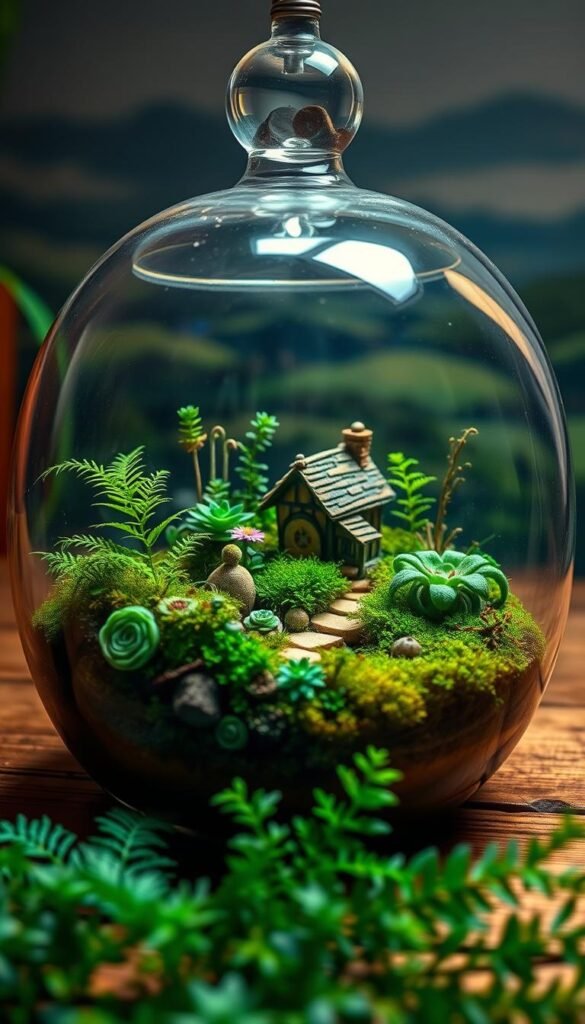Imagine a tiny, thriving universe on your coffee table. These captivating glass displays blend living plants with creative design, offering a slice of nature that fits perfectly in modern homes. Unlike traditional gardens, these self-contained ecosystems require minimal care while adding vibrant life to any room.
What makes these tiny landscapes so special? They create their own moisture cycle, recycling water through condensation and evaporation. This clever process means you can enjoy greenery without daily watering. Whether you choose air plants or delicate mosses, each selection plays a vital role in maintaining equilibrium.
You’ll find that success lies in understanding three core elements: light exposure, airflow, and substrate composition. Too much humidity? Your greenery might wilt. Not enough? Growth could stall. We’ll show you how to spot early warning signs and make simple adjustments.
By mastering these basics, you’ll keep your miniature oasis flourishing. Discover how to combine practical care with artistic flair – transforming glass containers into living art that sparks joy every time you glance their way.
Understanding the Fairy Garden Terrarium Ecosystem
Creating a thriving miniature ecosystem starts with understanding its core structure. Glass containers offer unique growing conditions, acting as protective bubbles where moisture and air circulate in delicate harmony. Let’s explore how design choices shape these tiny worlds.
Closed Systems: Nature’s Water Cycle
Sealed containers create self-contained environments. Evaporation lifts water from soil and leaves, which condenses on the glass and drips back down. This loop reduces watering needs but requires careful plant selection. Tropical species thrive here, while desert varieties may struggle.
Open Designs: Breezy Simplicity
Containers without lids suit plants needing airflow. Succulents and cacti prefer these drier setups where humidity stays low. You’ll water more often, but gain flexibility to arrange decorative elements. Open models work well in spaces with consistent temperatures.
| Type | Humidity Level | Best For | Maintenance |
|---|---|---|---|
| Closed | High (70-90%) | Ferns, mosses | Water every 4-6 weeks |
| Open | Low (30-50%) | Succulents, air plants | Mist weekly |
Three factors determine ecosystem health: morning condensation that fades by noon, steady leaf growth, and clean glass surfaces. Spotting fuzzy mold or soggy soil? Adjust airflow or light exposure to restore balance.
Selecting the Right Plants for Vibrant Growth
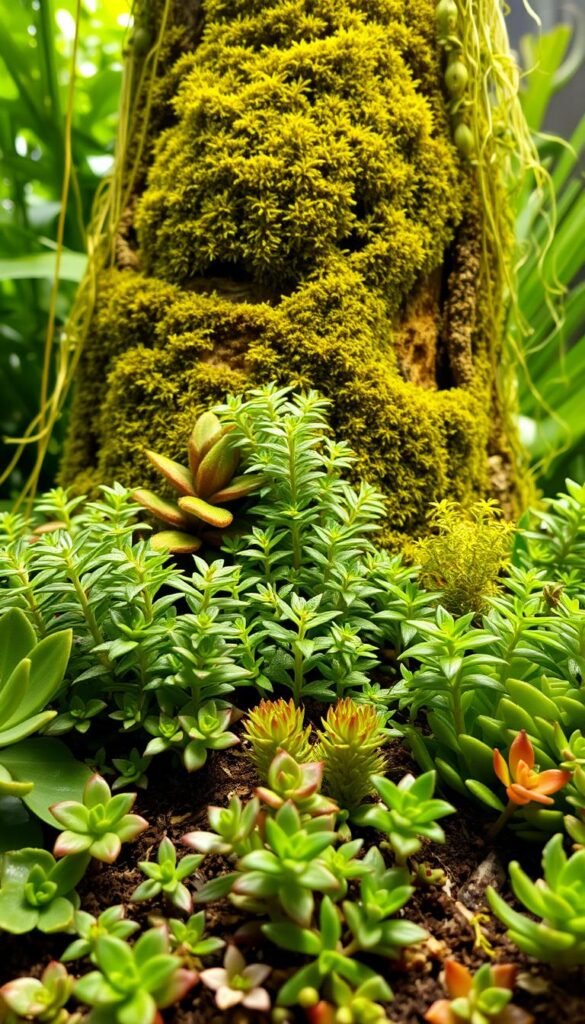
Curating plant life for your miniature ecosystem feels like assembling a puzzle. Each species must contribute to the whole while thriving in its unique spot. Let’s simplify the selection process so your glass habitat bursts with life year-round.
Plant Compatibility in Terrarium Environments
Grouping species with matching needs prevents competition. Tropical ferns pair beautifully with nerve plants in humid setups, while desert succulents form sun-loving clusters. Air plants defy convention, clinging to driftwood without soil.
| Environment | Top Picks | Key Benefit |
|---|---|---|
| Closed Systems | Parlour Palm, Fittonia | Thrives in humidity |
| Open Designs | Echeveria, Haworthia | Loves airflow |
Ideal Choices for Open and Closed Setups
Sealed containers demand moisture lovers. Try these:
- Fittonia’s pink veins pop against green leaves
- Maidenhair fern’s delicate fronds create texture
- Mini orchids add floral surprises
For open displays, jade plants and zebra cacti offer sculptural shapes. Remember: slow-growing varieties stay proportionate. Pair these picks with smart watering techniques to prevent root rot.
“The right plant combinations turn glass jars into living dioramas – each leaf telling part of the story.”
Mosses work as natural carpets, binding soil and retaining moisture. Scale matters most: a coffee plant seedling enchants now but will outgrow its home in months. Stick to species under 6″ tall for lasting harmony.
Setting Up Soil, Lighting, and Temperature for Success
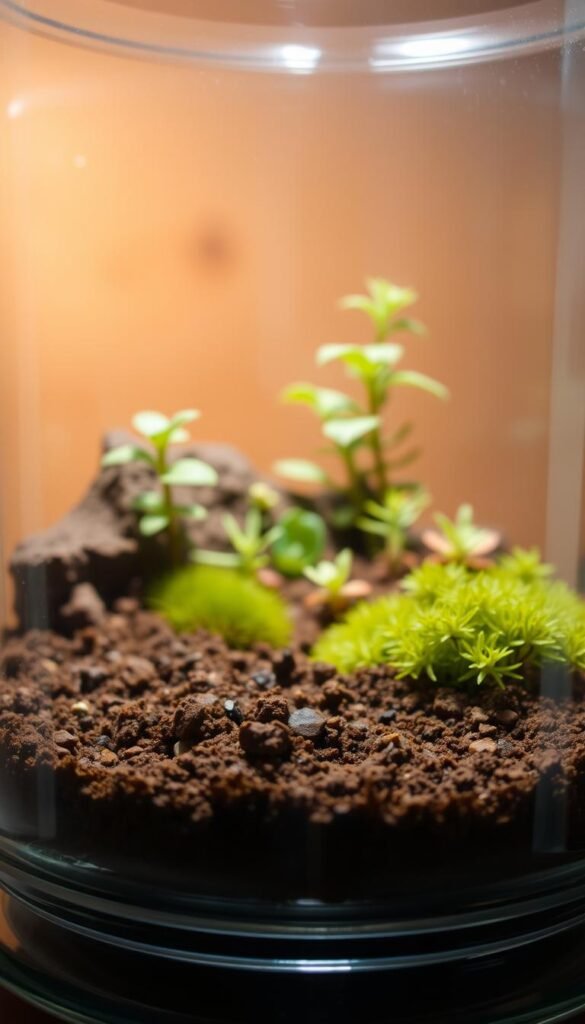
Building a thriving miniature world requires three pillars: smart foundation design, strategic light placement, and climate control. These elements work together to create conditions where roots breathe easy and leaves glow with vitality.
Soil Composition and Drainage Best Practices
Start with a base layer of pebbles or gravel for drainage. Add activated charcoal to filter impurities, then top with sphagnum moss to prevent soil settling. Use a lightweight potting mix – combine 2 parts peat moss with 1 part perlite for airy texture.
Lighting Strategies for Healthy Growth
Position your container 3-5 feet from east-facing windows. Morning sun gently fuels photosynthesis without scorching leaves. For spaces with limited natural light, LED grow lights placed 12″ above the glass provide steady energy.
| Factor | Key Components | Requirements |
|---|---|---|
| Soil | Drainage layer, charcoal, potting mix | Prevents waterlogging |
| Light | Indirect sunlight or full-spectrum LEDs | 6-8 hours daily |
| Temperature | Consistent room climate | 60-75°F ideal range |
Maintaining Stable Indoor Temperatures
Keep your display away from radiators and AC vents. Glass amplifies heat – if surfaces feel warm to touch, move it further from windows. Nighttime drops below 55°F? Relocate temporarily to warmer spots.
Rotate the container quarterly for even light distribution. In winter, extend artificial lighting by 2 hours. Summer months might require light-filtering curtains to prevent overheating.
Watering Techniques and Humidity Control Tips
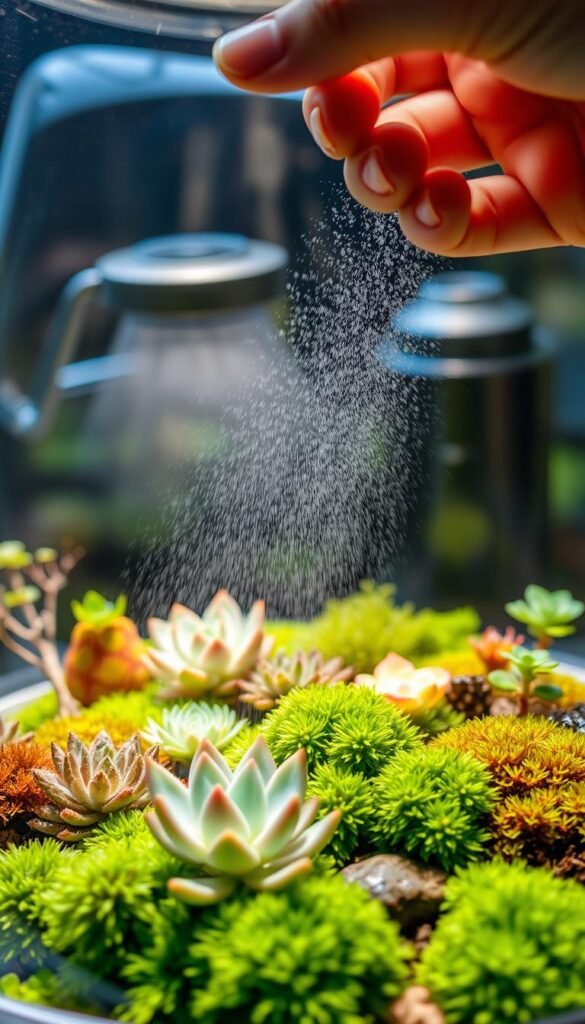
Mastering moisture levels transforms your glass ecosystem from fragile to flourishing. Whether you nurture a sealed jungle or an arid landscape, smart hydration keeps roots happy and leaves vibrant. Let’s decode the art of precision watering.
Balancing Moisture Without Overwatering
Closed systems thrive on neglect – their recycled humidity means monthly sips suffice. If glass walls stay foggy past midday, skip watering. Open designs demand weekly attention, especially near sunny windows. Test soil with your finger: dampness at knuckle-depth signals enough moisture.
Watch for yellow leaves (too wet) or crispy edges (too dry). Closed containers rarely need quick fixes for overwatered plants if you follow the “less is more” rule. For open setups, water roots directly using a narrow-spout bottle to avoid leaf rot.
Effective Misting Practices
Morning misting mimics natural dew cycles. Use room-temperature water and aim upward – let droplets fall gently onto leaves. Tropical species love 80% humidity; desert dwellers prefer 40%. Adjust frequency seasonally: more in dry winters, less during humid summers.
Clear condensation indicates balanced humidity control. Persistent fog? Wipe glass and crack lids briefly. Pair misting with airflow – oscillating fans prevent stagnant air without blasting delicate foliage. Remember: healthy roots need oxygen as much as water.
Fairy Garden Terrarium Maintenance: Keeping Moisture and Plants in Balance
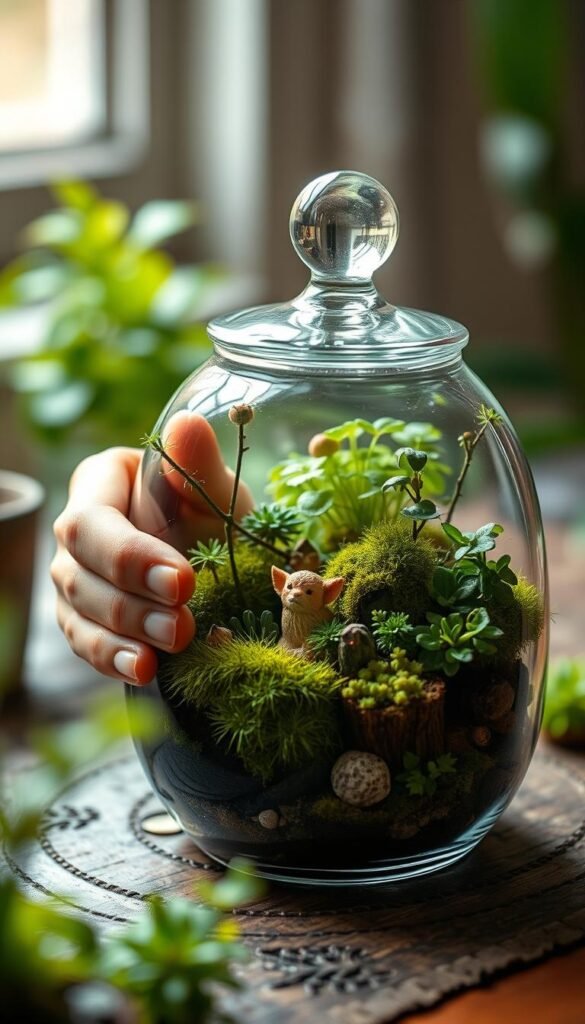
Crafting a magical glass world brings daily wonder, but its longevity depends on smart routines. Weekly checks become your secret weapon – glance at foliage color, soil texture, and decorative accents during morning coffee. These quick inspections help spot yellowing leaves or foggy glass before issues escalate.
| Frequency | Checkpoints | Action Steps |
|---|---|---|
| Weekly | Condensation patterns, soil dampness | Wipe glass, rotate container |
| Monthly | Root health, decor stability | Trim growth, secure miniatures |
Seasonal shifts demand adjustments. Winter’s dry air? Mist open containers twice weekly. Summer humidity? Reduce watering by half. Your plants will signal needs – perky leaves mean happy roots, while drooping suggests thirst.
Balance decorative charm with practical care by choosing moss-safe cleaners for tiny benches. A soft brush keeps miniature pathways clear without disturbing the soil. Remember: thriving displays blend aesthetics with ecosystem science.
“The best caretakers become ecosystem detectives – noticing subtle changes before they become problems.”
With these tips, your living artwork matures gracefully. Proper attention prevents mold and keeps tiny landscapes storybook-ready. Soon, you’ll instinctively know when to intervene – and when to let nature work its magic.
Pruning, Trimming, and Cleaning for a Neat Terrarium
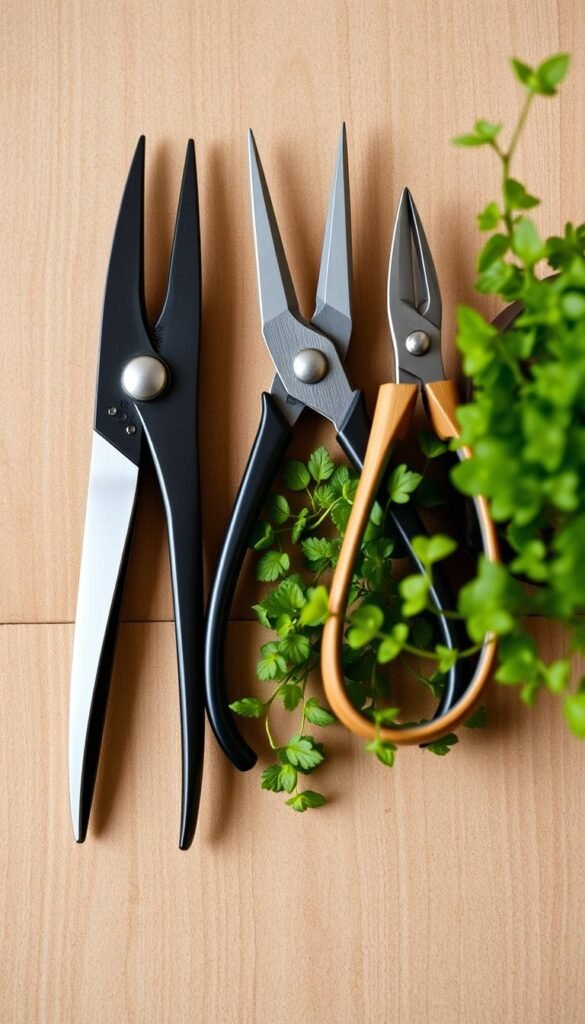
A well-groomed glass ecosystem becomes a living sculpture through careful shaping. Like bonsai artists, you’ll learn to enhance natural beauty while directing growth patterns. This delicate dance between control and creativity keeps your miniature world photogenic and healthy.
Spotting Trouble: When to Intervene
Discolored leaves often signal the first need for action. Look for brown edges on ferns or yellow patches in moss carpets. Overcrowded stems block light – if lower sections appear sparse, it’s time to thin upper foliage.
Precision Care Tools
Specialized implements make working in tight space effortless. Curved scissors reach behind decorative rocks, while angled tweezers pluck debris without disturbing neighboring stems. Always sterilize tools with rubbing alcohol between uses.
| Tool | Best Use | Benefit |
|---|---|---|
| Micro Scissors | Leaf trimming | Clean cuts heal faster |
| Long Tweezers | Debris removal | Preserves soil structure |
| Soft Brush | Surface cleaning | Prevents mold growth |
Trim just above leaf nodes to encourage bushier growth. Remove no more than 20% of foliage at once – drastic cuts stress delicate systems. Wipe glass weekly with a microfiber cloth to maintain crystal-clear views.
“Strategic pruning isn’t about restriction – it’s guiding each plant to showcase its best self within the collective design.”
Rotate specimens monthly to ensure even light distribution. After trimming, mist lightly to reduce shock. With these techniques, your tiny jungle stays lush without losing its storybook charm.
Monitoring Temperature and Ensuring Proper Air Circulation
Your glass ecosystem thrives when its climate feels just right. Glass amplifies both warmth and chill, creating unique challenges. Finding that sweet spot between cozy and extreme makes all the difference for delicate roots and leaves.
Smart Climate Management
Keep displays at least 3 feet from radiators and AC vents. Drafty windows cause temperature swings – opt for interior shelves instead. Closed containers need 60-75°F to maintain their water cycle without cooking plants.
Watch for curled leaves or slowed growth – these signal temperature stress. Rotate containers weekly to prevent hot spots. In winter, move displays away from cold glass panes overnight.
Fresh Air Strategies
Crack open sealed lids for 30 minutes weekly to refresh air circulation. Use a small desk fan on low settings 6 feet away for open designs. This gentle breeze mimics natural wind without drying soil.
Seasonal shifts demand adjustments. Summer humidity? Wipe condensation daily. Dry winters? Group displays with other houseplants to create moisture-rich conditions. Your green companions will reward you with vibrant growth year-round.

